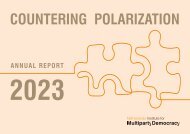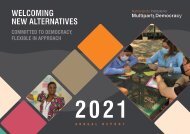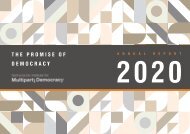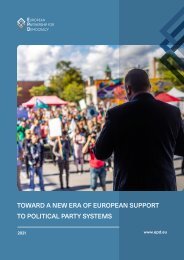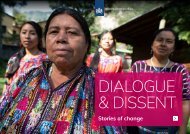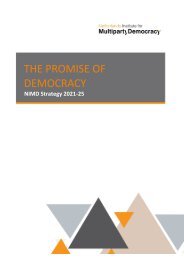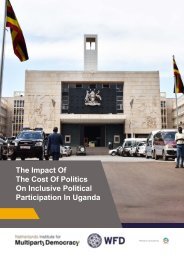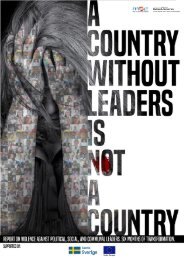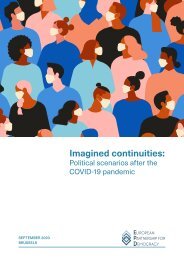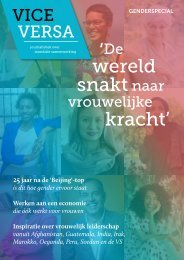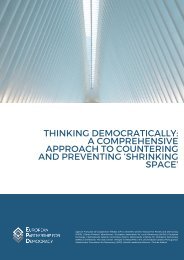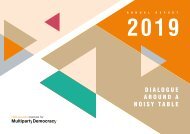Repression and resilience: Diagnosing closing space mid-pandemic
Create successful ePaper yourself
Turn your PDF publications into a flip-book with our unique Google optimized e-Paper software.
REPRESSION AND RESILIENCE: DIAGNOSING CLOSING SPACE MID-PANDEMIC<br />
25<br />
Closing digital <strong>space</strong><br />
The COVID p<strong>and</strong>emic has undoubtedly accelerated<br />
digital transformation in many areas, but also altered<br />
virtual civic <strong>space</strong>. 86 In 2018, the UN Human Rights Council<br />
re-affirmed that “the same rights that people have offline<br />
must also be protected online.” 87 When offline <strong>space</strong><br />
is being restricted, digital democratic <strong>space</strong> can often<br />
provide a refuge for activists. 88 In many countries, online<br />
demonstrations took place as a way of protesting in a<br />
socially distanced manner. This expansion of democratic<br />
<strong>space</strong> to the digital public sphere has, however, also<br />
come with new tactics <strong>and</strong> tools for <strong>closing</strong> <strong>space</strong>, such<br />
as online censorship <strong>and</strong> surveillance. UN human rights<br />
experts have warned of increased patterns of <strong>closing</strong><br />
digital <strong>space</strong>s a<strong>mid</strong> the COVID-19 p<strong>and</strong>emic <strong>and</strong> Freedom<br />
House has reported a constant deterioration of digital<br />
rights, leading to a rise of “digital authoritarianism” 89 .<br />
The case studies similarly noted how the p<strong>and</strong>emic<br />
resulted in an increase of attacks on free speech online,<br />
particularly directed at students, academics, journalists<br />
<strong>and</strong> activists. In Indonesia, people were subjected to<br />
online harassment <strong>and</strong> inti<strong>mid</strong>ation for criticising the<br />
government <strong>and</strong> discussing politics online, <strong>and</strong> some<br />
activists even had their WhatsApp accounts hijacked <strong>and</strong><br />
used to send provocative messages so that the police<br />
would use this as evidence against them. In the name<br />
of combating the p<strong>and</strong>emic, governments misused<br />
technology to restrict their citizens’ digital rights, including<br />
individuals’ right to privacy, freedom of expression<br />
<strong>and</strong> association, <strong>and</strong> access to information. 90 91 Some<br />
of the methods used to close virtual democratic <strong>space</strong><br />
included surveillance measures, targeted disinformation,<br />
restrictions imposed on mobile or internet connections<br />
<strong>and</strong> attacks on activists for expressing their political<br />
opinion online 92 .<br />
Surveillance measures are unlawful unless governments<br />
prove that the “measures implemented are provided for<br />
by law <strong>and</strong> are necessary, proportionate, time-bound,<br />
<strong>and</strong> that they are implemented with transparency <strong>and</strong><br />
adequate oversight.” 93 And yet such measures have<br />
been applied in a particularly intrusive manner during<br />
the p<strong>and</strong>emic. Contact-tracing apps became a preferred<br />
measure by governments to track citizens’ interactions,<br />
with major privacy risks. In Colombia, the apps were<br />
installed automatically on people’s phones <strong>and</strong><br />
presented as m<strong>and</strong>atory, which amounted to a “form of<br />
state surveillance that was unconstitutional <strong>and</strong> openly<br />
breached the citizens’ right to privacy.”<br />
In addition to mass surveillance <strong>and</strong> free speech<br />
infringements enabled by new technologies, other tools<br />
to restrict democratic <strong>space</strong> online include the mass<br />
interception of online communication; the amplification of<br />
disinformation, hate speech <strong>and</strong> gender-based violence<br />
on online platforms; the manipulation of public opinion<br />
through targeted advertising; <strong>and</strong> internet shutdowns.<br />
By accelerating widespread digitalisation, the p<strong>and</strong>emic<br />
has ultimately opened up opportunities for states <strong>and</strong><br />
non-state actors to shape, censor <strong>and</strong> close down new<br />
<strong>space</strong>s for contestation online.<br />
86 OECD (2020): “Digital transformation <strong>and</strong> the futures of civic <strong>space</strong> to 2030”. OECD Development Policy Papers, No. 29, Paris: OECD<br />
Publishing. Available here.<br />
87 United Nations Human Rights Council (2018): Resolution: The promotion, protection <strong>and</strong> enjoyment of human rights on the Internet (4<br />
July 2018). Available here.<br />
88 Roberts, T. (ed.) (2021): Digital Rights in Closing Civic Space: Lessons from Ten African Countries. Brighton: Institute of Development<br />
Studies. DOI: 10.19088/IDS.2021.003.<br />
89 Freedom House (2018): “The Rise of Digital Authoritarianism”. Available here.<br />
90 International IDEA (2020): “Global Democracy & COVID-19:Upgrading International Support”. Available here.<br />
91 Freedom House (2020): “The p<strong>and</strong>emic is fueling digital repression worldwide”. Available here.<br />
92 Roberts, T. (ed.) (2021): Digital Rights in Closing Civic Space: Lessons from Ten African Countries. Brighton: Institute of Development<br />
Studies. DOI: 10.19088/IDS.2021.003.<br />
93 Amnesty International (2020): COVID-19, surveillance <strong>and</strong> the threat to your rights. Available here.




